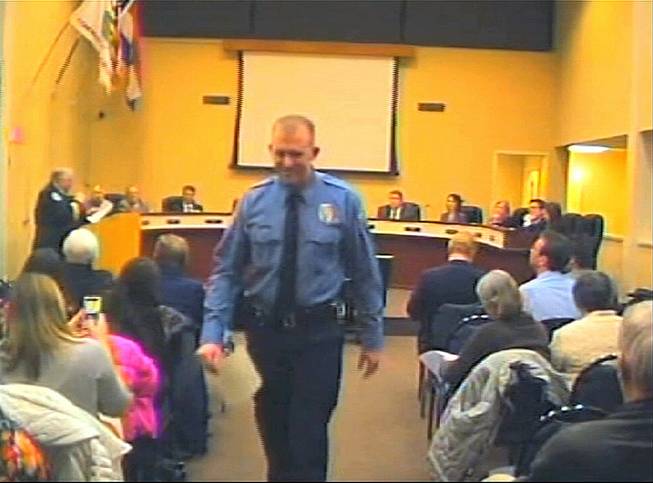
AP Photo/City of Ferguson
In this Feb. 11, 2014, image from video released by the City of Ferguson, Mo., officer Darren Wilson attends a city council meeting in Ferguson. Police identified Wilson, 28, as the police officer who shot Michael Brown on Aug. 9, 2014, sparking over a week of protests in the suburban St. Louis town.
Monday, Nov. 24, 2014 | 11:50 p.m.
The most credible eyewitnesses to the shooting death of Michael Brown in Ferguson, Missouri, said he had charged toward Police Officer Darren Wilson just before the final, fatal shots, the St. Louis County prosecutor said Monday night as he sought to explain why a grand jury had not found probable cause to indict the officer.
The accounts of several other witnesses from the Ferguson neighborhood where Brown, 18 and unarmed, met his death on Aug. 9 — including those who said Brown was trying to surrender — changed over time or were inconsistent with physical evidence, the prosecutor, Robert P. McCulloch, said in a news conference.
“The duty of the grand jury is to separate fact and fiction,” he said in a statement watched by a tense nation. “No probable cause exists to file any charges against Darren Wilson.”
McCulloch praised the grand jurors, who met on 25 days over a three-month period and heard 60 witnesses, for pouring “their hearts and souls into this process” and said that only by hearing all the evidence, as they had, could one fairly judge the case.
The task facing the St. Louis County grand jury was not to determine whether Wilson was guilty of a crime, but whether there was evidence to justify bringing charges, which could have ranged from negligent manslaughter to intentional murder.
The fact that at least nine members of the 12-member panel could not agree to indict the officer indicates that they accepted the narrative of self-defense put forth by Wilson in his voluntary, four hours of testimony before the grand jury. McCulloch, in his summary of the months of testimony, said it was supported by the most reliable eyewitness accounts - from African-Americans in the vicinity of the shooting - as well as physical evidence and the consistent results of three autopsies.
At issue, under the Missouri law governing use of deadly force by law enforcement as well as general rules for self-defense, was if Wilson “reasonably believed” that he or others were in serious danger.
According to transcripts released Monday night, Wilson testified that after he encountered Brown and a friend walking in the street, he realized the pair might be those being sought for stealing cigarillos from a convenience store minutes earlier.
According to witnesses and blood and other evidence found inside the car, Wilson first fired two shots while he struggled with Brown through the window of his patrol vehicle, a Chevrolet Tahoe, grazing Brown’s hand.
Brown started to run away, with Wilson in chase, then stopped and turned. According to the prosecutor’s summary, the officer fired five shots as Brown charged him, then another five shots as he made what one witness called a “full charge.”
Only 90 seconds passed between Wilson’s first encounter with the youths and the arrival of a backup police car, just after the shooting stopped, the prosecutor said.
Probable cause is not a stiff standard. It does not require that most of the evidence be incriminating, let alone be proof “beyond a reasonable doubt,” as required in a criminal trial. Instead, grand juries are ordinarily instructed to issue an indictment when there is “some evidence” of guilt, legal experts said.
To Brown’s parents and their supporters, the case for bringing at least some charge in this case seemed open and shut. But the jurors also had to consider whether Wilson acted within the limits of the lethal-force law, raising the threshold for an indictment.
Independent legal experts said it was impossible to analyze the grand jury decision without studying the transcripts of the testimony as well as the police reports, autopsies and forensic evidence that might shed light on what Brown was doing in his final seconds: whether he was menacing the officer or, as a friend who was with him said, trying to surrender.
Some people claiming to be eyewitnesses said Brown was shot in the back, McCulloch said, but later changed their stories when autopsies found no injuries entering his back. But others, African-Americans who did not speak out publicly, he said, consistently said that the youth had menaced the officer.
McCulloch had promised that he would allay any suspicions about the fairness of the proceedings by releasing, with names redacted, transcripts of testimony and other evidence heard by the panel.
The release of grand jury information, secret by law, is rare, and McCulloch originally said he would first seek a judge’s permission. But on Monday, his office said it had determined that it had a right to release most of the transcripts and it did so Monday night.
The grand jury, which included three African-Americans, deliberated for two days. By law, the final vote on whether to bring an indictment is secret and the jurors are legally prohibited from discussing their deliberations.
The U.S. Justice Department is conducting a separate investigation of whether Wilson, who is white, intentionally acted to deprive Brown, an African-American, of his civil rights. But the bar for such cases is a high one, and officials have privately said they are unlikely to bring federal charges. The Justice Department is also conducting a broader investigation into the practices of the Ferguson Police Department.


Join the Discussion:
Check this out for a full explanation of our conversion to the LiveFyre commenting system and instructions on how to sign up for an account.
Full comments policy